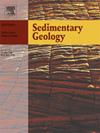Paleohydrological features and detrital compositions of the Late Triassic Chinle Formation in southwestern Utah, U.S.A
IF 2.9
2区 地球科学
Q1 GEOLOGY
引用次数: 0
Abstract
The present study reconstructed the early Norian drainage basin in equatorial western Pangaea based on paleohydrological and petrographical analyses of the Chinle Formation in southwestern Utah, U.S.A. The formation in this region is subdivided into the Shinarump and Cameron members, and the “purple pedogenic beds” in ascending order, and is characterized mainly by fluvial channel and channel complex deposits and pedogenically modified muddy floodplain deposits. Paleohydrological features, which were calculated using the thicknesses of bar deposits and cross-sets, show an upward decrease in bankfull discharges, and revealed the length of estimated upstream drainage basins of up to 260–640 km to the south of the study area. The clast compositions of the conglomerate demonstrate an upward decrease in quartzite and quartz, and an upward increase in chert and acidic volcanic rock fragments. The framework compositions of the 53 sandstone samples indicate that the Shinarump Member has a higher quartz grain content than the Cameron Member. X-ray diffraction analyses of 74 mudstone samples indicate that the clay mineral composition of the Shinarump Member consists of nearly equal amounts of illite and kaolinite, and less chlorite. The Cameron Member and the “purple pedogenic beds” are characterized by a dominance of kaolinite and smectite. No authigenic structures of the clay minerals were observed in scanning electron microscope images, and so most clay minerals are of clastic origin. Stratigraphic variations in the clast composition of conglomerate, and the detrital compositions of sandstone and mudstone, are interpreted to have been controlled by a combination of multiple factors: a temporal decrease in the intensity of chemical weathering of the source rocks due to climatic drying with seasonality, enhancement of volcanic activity in the provenance terranes, and erosion of the basement rocks in the source areas. These compositions differ slightly from those of the Chinle Formation in the Four Corners region, which is located 300 to 400 km east of the study area. These differences suggest the development of two distinct drainage basins. In addition, the reconstructed short length of the drainage basins indicates that the source areas of the Chinle Formation in southwestern Utah were mainly the Mogollon Highlands and Cordilleran volcanic arc, and the headwaters were interpreted as not extending to the East Mexico arc.
美国犹他州西南部晚三叠世钦勒组古水文特征及碎屑组成
本文通过对美国犹他州西南部Chinle组的古水文和岩石学分析,重建了赤道泛大陆西部早诺里亚期流域,该地区的地层由高到低分为Shinarump组和Cameron组,以及“紫色成土层”,主要以河流河道和河道复合沉积以及成土改造的泥质洪泛平原沉积为特征。利用砂坝和交叉集的厚度计算的古水文特征表明,河岸流量呈上升趋势,并揭示了研究区以南估计的上游流域长度达260-640 km。砾岩的碎屑组成表现为石英岩和石英向上减少,燧石和酸性火山岩碎屑向上增加。53个砂岩样品的格架组成表明,Shinarump段的石英颗粒含量高于Cameron段。74个泥岩样品的x射线衍射分析表明,Shinarump段的粘土矿物组成由几乎等量的伊利石和高岭石组成,绿泥石较少。卡梅隆段和“紫色成壤层”以高岭石和蒙脱石为主。扫描电镜图未见粘土矿物自生结构,多数粘土矿物为碎屑成因。砾岩碎屑组成、砂岩和泥岩碎屑组成的地层变化被解释为受多种因素的综合控制:由于季节性气候干燥导致烃源岩化学风化强度的时间减弱,物源地体火山活动的增强,以及烃源区基底岩的侵蚀。这些成分与位于研究区以东300 ~ 400公里的四角地区的Chinle组略有不同。这些差异表明两个不同的流域发育。此外,重建的流域长度较短,表明犹他州西南部Chinle组烃源区主要为Mogollon高地和Cordilleran火山弧,其源头未延伸至东墨西哥弧。
本文章由计算机程序翻译,如有差异,请以英文原文为准。
求助全文
约1分钟内获得全文
求助全文
来源期刊

Sedimentary Geology
地学-地质学
CiteScore
5.10
自引率
7.10%
发文量
133
审稿时长
32 days
期刊介绍:
Sedimentary Geology is a journal that rapidly publishes high quality, original research and review papers that cover all aspects of sediments and sedimentary rocks at all spatial and temporal scales. Submitted papers must make a significant contribution to the field of study and must place the research in a broad context, so that it is of interest to the diverse, international readership of the journal. Papers that are largely descriptive in nature, of limited scope or local geographical significance, or based on limited data will not be considered for publication.
 求助内容:
求助内容: 应助结果提醒方式:
应助结果提醒方式:


